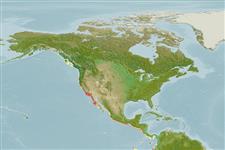Common names from other countries
Classification / Names / Names
Common names | Synonyms | Catalog of Fishes (gen., sp.) | ITIS | CoL | WoRMS
Environment: milieu / climate zone / depth range / distribution range
Ecology
Sessile; depth range 0 - 26 m (Ref. 865). Subtropical
Eastern Central Pacific: Central California to central Baja California.
Length at first maturity / Size / Weight / Age
Maturity: Lm ? range ? - ? cm Max length : 100.0 cm TL male/unsexed; (Ref. 865)
Massive, smooth, gray with leathery texture, numerous crater-like oscula on the outer ridge (Ref. 865). May grow to thickness of 30 cm and 100 cm in length (Ref. 865).
Life cycle and mating behavior
Maturity | Reproduction | Spawning | Eggs | Fecundity | Larvae
Members of the class Demospongiae are hermaphroditic. Life cycle: The zygote develops into parenchymella larva (free-swimming) before settling down on a substrate where it grows into a young sponge.
Bisby, F.A., M.A. Ruggiero, K.L. Wilson, M. Cachuela-Palacio, S.W. Kimani, Y.R. Roskov, A. Soulier-Perkins and J. van Hertum. 2005. (Ref. 19)
IUCN Red List Status (Ref. 130435)
CITES status (Ref. 108899)
Not Evaluated
Not Evaluated
Human uses
| FishSource |
Tools
More information
Age/Size
Growth
Length-weight
Length-length
Morphology
Larvae
Abundance
Internet sources
Estimates based on models
Preferred temperature
(Ref.
115969): 14 - 22.3, mean 17.8 (based on 44 cells).
Price category
Unknown.
